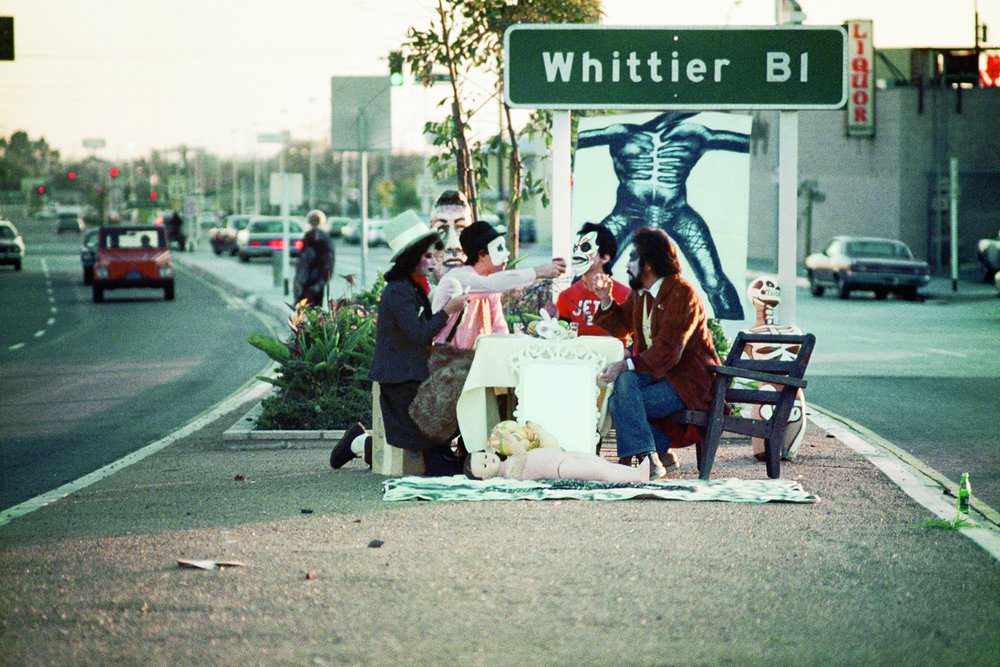Museum Ludwig, Cologne, Germany
20 Jun 2020 - 23 Aug 2020

Harry Gamboa Jr., from the Asco era First Supper (After A Major Riot), 1974, © 1974, Harry Gamboa Jr.
The exhibition Mapping the Collection takes a new look at two influential decades in American (art) history: the 1960s and 1970s. The exhibition presents a selection of artworks from the Museum Ludwig’s collection by female, queer, and indigenous artists as well as artists of color who are not represented in the collection, as an impetus for a broader reception of American art. The political and social events and developments of these two decades form the background against which our Western European conception and reception of American art history is critically questioned.
From a European perspective, when we think of the 1960s and 1970s in the United States we mainly remember the African-American civil rights movement, the assassinations of John F. Kennedy and Martin Luther King Jr., and the protests against the Vietnam War. However, we know little about the Brown Berets, the activists of the American Indian Movement, or the beginnings of gay liberation. Characteristic examples of art from this period include works by Andy Warhol, Roy Lichtenstein, Donald Judd, Robert Smithson, Robert Rauschenberg, and Robert Indiana. African-American artists, on the other hand, are barely present in the narrative of twentieth-century American art, and indigenous or Latinx artists even less so. Yet they of course also made important contributions to the development of art and culture in the United States.
In addition to art works by these renowned artists from the Museum Ludwig’s collection, Mapping the Collection also features works by lesser-known artists, such as David Wojnarowicz and Leon Polk Smith, who are also represented in the collection, alongside loans of works by Senga Nengudi, Adrian Piper, and T.C. Cannon (Kiowa/Caddo). The aim is on the one hand to show how artists reacted to the social and political developments of these two decades and, on the other hand, to demonstrate that formal and stylistic developments and the exchange of ideas did not stop at the boundaries of gender and race. This combination also brings previously overlooked connections and alliances among artists and between artists and activists to the surface, which demonstrates that art always remains connected to the social and political context of its creation. At the same time, it underscores the obstacles faced by artists from indigenous, African-American, and other marginalized communities, as well as the influence that artists’ background—in regard to race, social class, and gender—has on the reception and understanding of art.
Mapping the Collection draws from feminist and queer discourses and questions the familiar (art) historical canon. But settler colonial theories are explored as well, taking the colonization of the American continent and the concomitant genocide of indigenous peoples as its point of departure. Through the addition of archival material, the works from the collection are “re”connected to the historical, political, and social context of their creation. This produces new links between artists, works, and art history. But the exhibition also examines the role of the museum itself in the creation and affirmation of these (art) historical narratives. Mapping the Collection raises questions about representation and agency that are as relevant today as they were then—in the United States and in Germany.
This exhibition is the result of the Terra Foundation Research Fellowship in American Art at the Museum Ludwig. Over a period of two years, the project focused on the collection of twentiethcentury American art at the Museum Ludwig and examined it with regard to postcolonial, feminist, queer, and gender-theoretical questions.
Artists: Asco, Vito Acconci, Ruth-Marion Baruch, T.C. Cannon (Kiowa/Caddo), Barbara Chase-Riboud, Edward Curtis, Dan Graham, David Hammons, Sharon Hayes, Robert Indiana, Pirkle Jones, Corita Kent (Sister Corita), Sherrie Levine, Roy Lichtenstein, Morris Louis, Gordon Matta-Clark, Ana Mendieta, Senga Nengudi, Louise Nevelson, Kenneth Noland, Claes Oldenburg, Adam Pendleton, Howardena Pindell, Adrian Piper, Yvonne Rainer, Robert Rauschenberg, Martha Rosler, Carolee Schneemann, Leon Polk Smith, Andy Warhol, Hannah Wilke, David Wojnarowicz
Curator: Janice Mitchell, Terra Foundation Fellow in American Art at the Museum Ludwig